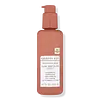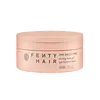What's inside
What's inside
 Key Ingredients
Key Ingredients

 Benefits
Benefits

 Concerns
Concerns

 Ingredients Side-by-side
Ingredients Side-by-side

Water
Skin ConditioningPolyquaternium-37
Phenoxyethanol
PreservativePolysorbate 20
EmulsifyingParfum
MaskingCetrimonium Chloride
AntimicrobialGlycolic Acid
BufferingEthylhexylglycerin
Skin ConditioningAminomethyl Propanol
BufferingPolyquaternium-7
Sodium PCA
HumectantSodium Lactate
BufferingArginine
MaskingAspartic Acid
MaskingPCA
HumectantGlycine
BufferingAlanine
MaskingSerine
MaskingValine
MaskingProline
Skin ConditioningThreonine
Histidine
HumectantIsoleucine
Skin ConditioningPersea Gratissima Oil
Skin ConditioningPhenylalanine
MaskingHelianthus Annuus Seed Oil
EmollientRicinus Communis Seed Oil
MaskingMangifera Indica Seed Butter
Skin ConditioningChamomilla Recutita Flower Extract
MaskingCaprylic/Capric Triglyceride
MaskingCoco-Glucoside
CleansingCarrageenan
Guar Hydroxypropyltrimonium Chloride
Skin ConditioningAlgin
MaskingSorbitan Oleate
EmulsifyingChitosan
Xanthan Gum
EmulsifyingWater, Polyquaternium-37, Phenoxyethanol, Polysorbate 20, Parfum, Cetrimonium Chloride, Glycolic Acid, Ethylhexylglycerin, Aminomethyl Propanol, Polyquaternium-7, Sodium PCA, Sodium Lactate, Arginine, Aspartic Acid, PCA, Glycine, Alanine, Serine, Valine, Proline, Threonine, Histidine, Isoleucine, Persea Gratissima Oil, Phenylalanine, Helianthus Annuus Seed Oil, Ricinus Communis Seed Oil, Mangifera Indica Seed Butter, Chamomilla Recutita Flower Extract, Caprylic/Capric Triglyceride, Coco-Glucoside, Carrageenan, Guar Hydroxypropyltrimonium Chloride, Algin, Sorbitan Oleate, Chitosan, Xanthan Gum
Water
Skin ConditioningGlycerin
HumectantPvp
Emulsion StabilisingCarbomer
Emulsion StabilisingPhyllostachys Bambusoides Extract
Skin ConditioningBambusa Vulgaris Extract
Skin ConditioningHydrolyzed Vegetable Protein
Skin ConditioningPereskia Aculeata Callus Extract
Panthenol
Skin ConditioningCamellia Sinensis Leaf Extract
AntimicrobialAlanine
MaskingArginine
MaskingAspartic Acid
MaskingGlycine
BufferingHistidine
HumectantIsoleucine
Skin ConditioningPhenylalanine
MaskingProline
Skin ConditioningSerine
MaskingThreonine
Valine
MaskingHydrolyzed Rice Protein
Skin ConditioningCalcium Gluconate
HumectantGalactoarabinan
Gluconolactone
Skin ConditioningMaltodextrin
AbsorbentMomordica Cochinchinensis Seed Extract
Skin ConditioningOryza Sativa Extract
AbsorbentPCA
HumectantPhytic Acid
Salvia Hispanica Seed Extract
EmollientSodium PCA
HumectantTrehalose
HumectantXylitol
HumectantAminomethyl Propanol
BufferingCaprylyl/Capryl Glucoside
CleansingEthyl Linoleate
EmollientEthyl Oleate
EmollientLactobacillus Ferment
Skin ConditioningMaltodextrin/Vp Copolymer
Pentaerythrityl Tetra-Di-T-Butyl Hydroxyhydrocinnamate
AntioxidantTocopherol
AntioxidantPolyquaternium-37
Sodium Phosphate
BufferingSorbitan Oleate
EmulsifyingPolyquaternium-59
UV AbsorberCaprylic Acid
CleansingPolysorbate 80
EmulsifyingLeuconostoc/Radish Root Ferment Filtrate
AntimicrobialSodium Lactate
BufferingPolysorbate 20
EmulsifyingButylene Glycol
HumectantCaprylyl Glycol
Emollient1,2-Hexanediol
Skin ConditioningEthylhexylglycerin
Skin ConditioningTropolone
Skin ConditioningPhenoxyethanol
PreservativeSodium Benzoate
MaskingBenzyl Alcohol
PerfumingParfum
MaskingAlpha-Isomethyl Ionone
PerfumingBenzyl Salicylate
PerfumingCoumarin
PerfumingEugenol
PerfumingGeraniol
PerfumingHydroxycitronellal
PerfumingLimonene
PerfumingLinalool
PerfumingWater, Glycerin, Pvp, Carbomer, Phyllostachys Bambusoides Extract, Bambusa Vulgaris Extract, Hydrolyzed Vegetable Protein, Pereskia Aculeata Callus Extract, Panthenol, Camellia Sinensis Leaf Extract, Alanine, Arginine, Aspartic Acid, Glycine, Histidine, Isoleucine, Phenylalanine, Proline, Serine, Threonine, Valine, Hydrolyzed Rice Protein, Calcium Gluconate, Galactoarabinan, Gluconolactone, Maltodextrin, Momordica Cochinchinensis Seed Extract, Oryza Sativa Extract, PCA, Phytic Acid, Salvia Hispanica Seed Extract, Sodium PCA, Trehalose, Xylitol, Aminomethyl Propanol, Caprylyl/Capryl Glucoside, Ethyl Linoleate, Ethyl Oleate, Lactobacillus Ferment, Maltodextrin/Vp Copolymer, Pentaerythrityl Tetra-Di-T-Butyl Hydroxyhydrocinnamate, Tocopherol, Polyquaternium-37, Sodium Phosphate, Sorbitan Oleate, Polyquaternium-59, Caprylic Acid, Polysorbate 80, Leuconostoc/Radish Root Ferment Filtrate, Sodium Lactate, Polysorbate 20, Butylene Glycol, Caprylyl Glycol, 1,2-Hexanediol, Ethylhexylglycerin, Tropolone, Phenoxyethanol, Sodium Benzoate, Benzyl Alcohol, Parfum, Alpha-Isomethyl Ionone, Benzyl Salicylate, Coumarin, Eugenol, Geraniol, Hydroxycitronellal, Limonene, Linalool
Ingredients Explained
These ingredients are found in both products.
Ingredients higher up in an ingredient list are typically present in a larger amount.
Alanine is an amino acid and is already found in the human body. Our skin uses alanine to build collagen, elastin, and keratin.
Aminomethyl Propanol is used to adjust the pH of products. It is also used as a base to create other organic compounds. Having a balanced pH is important for protecting your skin.
Aminomethyl propanol is safe to use in cosmetics up to 1%. It is soluble in water.
Arginine is an amino acid that is important for human development. Your body uses is it to produce hair keratin and skin collagen.
As a cosmetic ingredient, Arginine has antioxidant properties and can also help repair damaged skin. This ingredient is derived either synthetically or from animals.
Arginine isn't fungal acne safe when used in the presence of other lipids (fats, fatty acids, oils, esters, etc). Oils and fats occur naturally within the skin, so take caution when using Arginine if you're prone to fungal acne.
Learn more about ArginineAspartic Acid is an amino acid that our bodies produce naturally. It is an antioxidant.
Our body uses Aspartic Acid to help build collagen and elastin. It also plays a role in hydrating skin.
Ethylhexylglycerin (we can't pronounce this either) is commonly used as a preservative and skin softener. It is derived from glyceryl.
You might see Ethylhexylglycerin often paired with other preservatives such as phenoxyethanol. Ethylhexylglycerin has been found to increase the effectiveness of these other preservatives.
This ingredient is an amino acid that helps build proteins and moisturizes skin. It is already present in our skin as our bodies produce them naturally.
Glycine already plays a role in helping keep our skin moisturized as amino acids transport moisture throughout our skin.
As collagen is made up of glycine and other amino acids, it is believed glycine may help our skin produce more collagen.
Learn more about GlycineHistidine is a semi-essential amino acid used by our bodies to create protein. It has humectant and skin conditioning properties.
Our bodies use histidine to create filaggrin - filaggrin is a structural protein that the skin uses in maintaining skin barrier.
One study found histidine and carnosine to be a dynamic duo for your skin:
Oral histidine has also been found to help with filaggrin-deficit skin disorders such as atopic dermatitis.
Why is it considered a semi-essential amino acid? This is because adults are able to create it but children must get it from their diet.
Learn more about HistidineIsoleucine is an amino acid that helps reinforce our skin barrier. This amino acid plays a role in creating protein for the body.
Fun fact: Isoleucine is found in meat, fish, dairy, legumes, and nuts.
Parfum is a catch-all term for an ingredient or more that is used to give a scent to products.
Also called "fragrance", this ingredient can be a blend of hundreds of chemicals or plant oils. This means every product with "fragrance" or "parfum" in the ingredients list is a different mixture.
For instance, Habanolide is a proprietary trade name for a specific aroma chemical. When used as a fragrance ingredient in cosmetics, most aroma chemicals fall under the broad labeling category of “FRAGRANCE” or “PARFUM” according to EU and US regulations.
The term 'parfum' or 'fragrance' is not regulated in many countries. In many cases, it is up to the brand to define this term.
For instance, many brands choose to label themselves as "fragrance-free" because they are not using synthetic fragrances. However, their products may still contain ingredients such as essential oils that are considered a fragrance by INCI standards.
One example is Calendula flower extract. Calendula is an essential oil that still imparts a scent or 'fragrance'.
Depending on the blend, the ingredients in the mixture can cause allergies and sensitivities on the skin. Some ingredients that are known EU allergens include linalool and citronellol.
Parfum can also be used to mask or cover an unpleasant scent.
The bottom line is: not all fragrances/parfum/ingredients are created equally. If you are worried about fragrances, we recommend taking a closer look at an ingredient. And of course, we always recommend speaking with a professional.
Learn more about ParfumPCA is derived from amino acids and is naturally found in our skin's barrier.
As a humectant, PCA helps draw and hold moisture to the skin. Studies show it is effective at helping the skin stay hydrated long-term.
Phenoxyethanol is a preservative that has germicide, antimicrobial, and aromatic properties. Studies show that phenoxyethanol can prevent microbial growth. By itself, it has a scent that is similar to that of a rose.
It's often used in formulations along with Caprylyl Glycol to preserve the shelf life of products.
Phenylalanine is an amino acid. It is a skin soothing and hydrating ingredient. Amino acids play a crucial role in wound healing and skin hydration.
This ingredient is also used to help even out skin tone due to its ability to disrupt the melanin production process.
Two structures of phenylalanine exist: L-phenylalanine and D-phenylalanine. L-phenylalanine is essential, this means our bodies cannot produce it naturally and we must get it from foods. Our bodies convert D-phenylalanine to neurotransmitters, and D-phenylalanine is found in our bodies naturally.
Some foods that contain L-phenylalanine include eggs, soybeans, beef, milk.
Learn more about PhenylalanineWe don't have a description for Polyquaternium-37 yet.
Polysorbate 20 is made by combining ethoxylation of sorbitan, ethylene oxide, and lauric acid. It is a mild cleansing agent, surfactant, and emulsifier.
As a surfactant, it helps collect dirt and oils for washing. Emulsifiers prevent oils and water from separating.
Polysorbate 20 also adds scent to a product. Since it is made using sorbitol, it has a sweet scent. Sorbitol can also be found in fruits such as apples and peaches.
The lauric acid used to create Polysorbate 20 is often derived from coconuts.
Polysorbate 20 may not be fungal acne safe.
Learn more about Polysorbate 20Proline is an amino-acid. It helps moisturize the skin and plays an important role in creating proteins.
Our skin uses proline as one of the building blocks for producing collagen.
In medicine, proline is used as an osmoprotectant. This means it helps prevent oxidative degradation in other drugs.
Our bodies are able to produce proline naturally, but certain conditions may inhibit this production. In that case, proline can be obtained from eating egg whites, soy protein, dairy products, asparagus, mushrooms, and seaweed.
Learn more about ProlineSerine is an amino acid naturally found in our body. Our bodies use amino acids to create protein.
Amino-acids help give keep our skin hydrated. They play an important role in the skin barrier, which keeps the skin plump and firm.
Serine is a non-essential amino acid, meaning we don't need to obtain it from eating foods.
Learn more about SerineSodium Lactate is the sodium salt of lactic acid, an AHA. It is a humectant and sometimes used to adjust the pH of a product.
This ingredient is part of our skin's NMF, or natural moisturizing factor. Our NMF is essential for the hydration of our top skin layers and plasticity of skin. NMF also influences our skin's natural acid mantle and pH, which protects our skin from harmful bacteria.
High percentages of Sodium Lactate can have an exfoliating effect.
Fun fact: Sodium Lactate is produced from fermented sugar.
Learn more about Sodium LactateSodium PCA is the sodium salt of pyroglutamic acid. It is naturally occurring in our skin's natural moisturizing factors where it works to maintain hydration.
The PCA stands for pyrrolidone carboxylic acid, a natural amino acid derivative.
This ingredient has skin conditioning, anti-inflammatory, and humectant properties. Humectants help hydrate your skin by drawing moisture from the air. This helps keep your skin moisturized.
Learn more about Sodium PCASorbitan Oleate is created from compounds in oleic acid and sorbitol.
It is used to stabilize a product by preventing ingredients from separating. Emulsifiers help keep ingredients together, such as oils and water.
According to a manufacturer, the ingredient Sorbitan Monooleate shares an INCI name with this one.
Sorbitan Oleate may not be fungal acne safe. It can also worsen oily skin.
Learn more about Sorbitan OleateThreonine is an amino-acid. It helps hydrate the skin and has antioxidant benefits.
Our skin uses threonine for creating collagen and elastin. Humans are not able to create threonine and must get it through eating foods such as fish, lentils, poultry, sesame seeds, and more.
Valine is an essential amino acid. It is used by our bodies for tissue repair and muscle growth.
An essential amino acid is one in which our bodies cannot naturally produce so we must get them through diet. Foods such as eggs, dairy, red meat, and fish contain valine.
This ingredient can either be derived from an animal product or be synthetically created.
Learn more about ValineWater. It's the most common cosmetic ingredient of all. You'll usually see it at the top of ingredient lists, meaning that it makes up the largest part of the product.
So why is it so popular? Water most often acts as a solvent - this means that it helps dissolve other ingredients into the formulation.
You'll also recognize water as that liquid we all need to stay alive. If you see this, drink a glass of water. Stay hydrated!
Learn more about Water